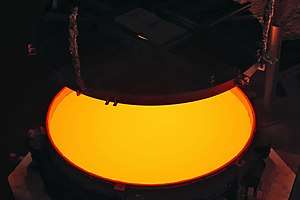Zerodur
Zerodur (notation of the manufacturer: ZERODUR®), a registered trademark of Schott AG,[2] is a lithium-aluminosilicate glass-ceramic[3] produced by Schott AG since 1968.[4] It has been used for a number of very large telescope mirrors including Keck I, Keck II,[5] and SOFIA, as well as some smaller telescopes (such as the GREGOR Solar Telescope). With its very low coefficient of thermal expansion it can be used to produce mirrors that retain acceptable figures in extremely cold environments such as deep space.[6] Although it has advantages for applications requiring a coefficient of thermal expansion less than that of borosilicate glass, it remains very expensive as compared to borosilicate. The tight tolerance on CTE, ±0.007×10−6 K−1, allows highly accurate applications that require high-precision.
Applications

- Optics
- Microlithography
- Measurement technology[4]
Properties
Zerodur has both an amorphous (vitreous) component and a crystalline component. Its most important properties[7] are:
- Particularly low thermal expansion: in the range 0 to 50 °C it has a mean of 0 ± 0.007×10−6 K−1, which is two orders of magnitude better than that of fused quartz.[8][9]
- High 3D homogeneity[9] with few inclusions, bubbles and internal stria (as contrasted to Cer-Vit).
- Hardness similar to borosilicate glass, so that it can be ground and polished more easily than fused quartz.
- High affinity for coatings.
- Low helium permeability.
- Non-porous (as contrasted to sintered ceramics).
- Good chemical stability similar to that of fused quartz.
- Fracture toughness approximately 0.9 MPa·m1/2.[3][10]
Physical properties
- Dispersion: (nF − nC) = 0.00967
- Density: 2.53 g/cm3 at 25 °C
- Young's Modulus: 9.1×1010 Pa
- Poisson Ratio: 0.24
- Specific heat capacity at 25 °C: 0.196 cal/(g·K) = 0.82 J/(g·K)
- Coefficient of thermal expansion (20 °C to 300 °C) : 0.05 ± 0.10×10−6/K
- Thermal conductivity: at 20 °C: 1.46 W/(m·K)
- Maximum application temperature: 600 °C
- Impact resistance behavior is substantially similar to other glass[11]
See also
References
- ↑ "Secondary Mirror of ELT Successfully Cast - Largest convex mirror blank ever created". www.eso.org. Retrieved 22 May 2017.
- ↑ "Archived copy". Archived from the original on July 24, 2011. Retrieved September 4, 2011.
- 1 2 Viens, Michael J (April 1990). "Fracture Toughness and Crack Growth of Zerodur" (PDF). NASA Technical Memorandum 4185. NASA. Retrieved 28 August 2011.
- 1 2 Schott AG Zerodur description Archived February 1, 2014, at the Wayback Machine.
- ↑ Döhring, Thorsten; Peter Hartmann; Ralf Jedamzik; Armin Thomas; Frank-Thomas Lentes. "Properties of Zerodur Mirror Blanks for Extremely Large Telescopes" (PDF). Proc. SPIE. SPIE. Retrieved 26 August 2011.
- ↑ Baer, JW; WP Lotz. "Figure testing of 300 mm Zerodur mirrors at cryogenic temperatures" (PDF). Retrieved 26 August 2011.
- ↑ "ZERODUR® Extremely Low Expansion Glass Ceramic: SCHOTT Advanced Optics - SCHOTT AG". www.schott.com. Retrieved 15 April 2018.
- ↑ SCHOTT CTE Grades Archived October 4, 2013, at the Wayback Machine.
- 1 2 http://optomechanicalservices.com/Papers.html
- ↑ Hartmann, P. (18 December 2012). "ZERODUR - Deterministic Approach for Strength Design" (PDF). NASA. Retrieved 11 September 2013.
- ↑ Senf, H; E Strassburger; H Rothenhausler (1997). "A study of Damage during Impact in Zerodur" (PDF). J Phys Iv France. 7 (Colloque C3, Suppltment au Journal de Physique I11 d'aotit 1997). Retrieved 31 August 2011.
